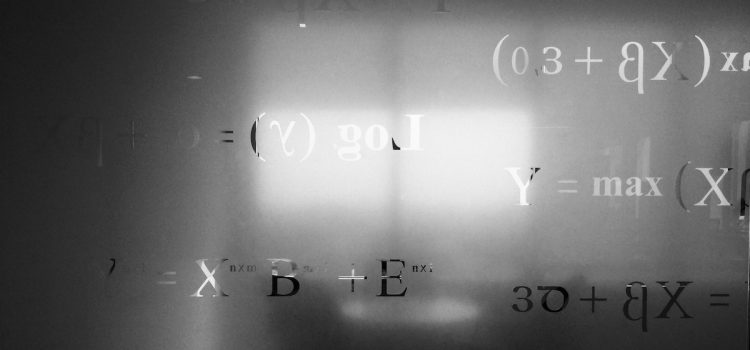

This article is an excerpt from the Shortform book guide to "The God Equation" by Michio Kaku. Shortform has the world's best summaries and analyses of books you should be reading.
Like this article? Sign up for a free trial here.
How can symmetry lead to scientific discoveries? What might symmetry imply about the universe?
Theoretical physicist Michio Kaku describes himself as agnostic. But, he finds it amazing that all the laws of physics can be summarized succinctly and that they display such symmetry. For him, the mathematical beauty of the laws of physics opens the door to the possibility that there’s a grand design.
Keep reading to learn why Kaku repeatedly points to symmetry in mathematics in his book The God Equation.
Symmetry in Mathematics
When discussing early scientific breakthroughs, Kaku calls attention to the fact that all of the equations describing motion and electromagnetism are symmetrical. What does this mean? An image of a face is symmetrical if you can flip it from left to right and the image remains the same. A cube is symmetrical in three dimensions because you can rotate it in any direction and the overall shape is unchanged. In mathematics, an equation is symmetrical if you can rearrange its expressions without altering its results.
Symmetry is a powerful mathematical tool. If you assume that symmetry is a property of a phenomenon you’re trying to explain, then symmetry can show where there are gaps in your knowledge and suggest what the “missing pieces” of a puzzle might look like. For example, the quest for symmetry led scientists to deduce the existence of antimatter—the inverse and opposite of regular matter—decades before it was proven to be real. Scientists find symmetry to be aesthetically pleasing, even elegant. But, Kaku warns that, just because a theory is pretty, it doesn’t necessarily mean that it’s true.
(Shortform note: The “antimatter” that Kaku brings up can be thought of as a mirror opposite to normal matter. For example, an electron is a subatomic particle with a negative electrical charge, whereas its antimatter counterpart, the positron, is an electron with a positive charge. When matter and antimatter particles collide, they annihilate each other, converting their mass into energy. In Astrophysics for People in a Hurry, Tyson explains that there had to have been a slight asymmetry in the amount of matter and antimatter in the early universe. Otherwise, they would have canceled out completely and there wouldn’t be any matter left in the universe today.)
Nevertheless, Kaku illustrates that, the more we learn about the laws of nature, the more it seems that symmetry is built into the universe’s basic set of rules. Newton’s laws of gravity and motion are symmetrical because they don’t depend on your frame of reference. If you look at an object’s motion upside down or sideways, the equations that govern it produce the same result. Maxwell’s equations are likewise symmetrical because you can freely swap their electrical and magnetic components. The property of symmetry repeatedly appears to be a defining characteristic of the universe.
| Symmetry’s Ups and Downs Why is symmetry such a pervasive concept that scientists can safely guess it plays a role in any problem’s solution? Perhaps because symmetry makes a theory resistant to change when tested under different frames of reference. In Astrophysics for People in a Hurry, Tyson says that the basic assumption of our current scientific paradigm is that the laws of nature don’t change over time or across space. Mathematical symmetry provides a means for a theory to meet this fundamental requirement while also, as Kaku suggests, offering a way for experimentalists to validate it by “filling in the gaps” that symmetry predicts. However, assumptions about symmetry can lead us astray. Human brains use symmetry as a pattern recognition tool, which sometimes makes us see things that aren’t there. For instance, in 1976, the Viking 1 spacecraft took an image of a mountain on Mars that seemed to resemble a human face. Some people jumped to the conclusion that this “face on Mars” was proof of alien life. However, if you look closely at the photo, you’ll notice that half of the face is in shadow. Your brain assumes symmetry and fills in the missing half with features you don’t actually see. Later photographs from the Mars Global Surveyor show the same mountain lit from a different angle, revealing that the symmetrical “face” was an illusion all along. |
Special Relativity
Einstein’s equations add layers of symmetry to Newton’s. The first is that, in relativity, you can substitute time for any direction in space. In other words, relativity is symmetrical in four dimensions, not just three. The second symmetry is similar to when Faraday showed that electricity and magnetism are interchangeable. In this case, Einstein revealed that energy and matter are equivalent to each other via his famous equation E=mc2 (energy equals mass times the speed of light squared). Therefore, says Kaku, special relativity unites energy and matter, as well as time and space.
Quantum Mechanics
In the early 1900s, our model of the atom was like a miniature solar system with a tiny, dense nucleus of protons and neutrons surrounded by orbiting electrons. However, theoretical physicist Max Planck noticed something strange about atomic behavior when he investigated the light given off by hot materials. According to equations based on Newton’s laws of motion, the atoms in hot materials vibrate faster than those at cooler temperatures, and they release their excess energy in the form of light. However, the math didn’t add up—the wavelengths of light emitted by hot, glowing matter didn’t match the predictions of Newtonian thermodynamics.
Kaku writes that Planck found a solution that was just as shocking to the norms of science as Einstein’s theory of relativity. In essence, Planck determined that the energy released by matter as it cools doesn’t diminish on a linear scale but as tiny bundles called “quanta.” It’s as if when an atom cools, its energy level doesn’t slide down a ramp but instead walks down a flight of stairs where each step is a specific amount of energy. This energy emerges as packets of light—photons—that exactly match the energy of light given off by heated objects.
| The Photoelectric Effect Thanks to symmetry, this process that Kaku describes also works in reverse. Just as electrons emit photons of light as they cool to lower energy levels, if you bombard a substance with light, it imbues electrons with extra energy, breaking some loose in what’s known as the photoelectric effect. This effect doesn’t depend on the intensity of the light, but rather on the frequency of the light waves. This doesn’t make sense under the Newtonian model of physics, which dictates that it’s the amount of energy that matters. However, in 1905, while still working on his theory of relativity, Einstein used Planck’s equations to explain the photoelectric effect. He showed that when the energy of photons at specific light frequencies matched electrons’ exact quantum energy levels, that alone was sufficient to knock the electrons into higher quantum energy states and even break them free from their atoms. It was for his explanation of the photoelectric effect that Einstein won the Nobel Prize in Physics, not for his work on relativity. |
The Heart of the Atom
The quest to unify relativity and quantum theory is ongoing. In the meantime, scientists pushed quantum mechanics further so they could unravel the secrets of the atom. To enter the subatomic realm, we’ll explain researchers’ methods to pry open the atom’s nucleus, the discovery of even smaller subatomic particles, and how combining the mathematical models of the forces which interact inside the atom leads to a theory of how all matter functions.
The only way to look inside atoms is to break them apart. Using accelerators, researchers smash atomic nuclei together and study the pieces found in the wreckage. When this was first done, physicists were surprised to find that protons and neutrons are composed of even smaller particles known as quarks. Studies revealed different types of quarks, and that protons, neutrons, and even stranger particles are made from arrangements of groups of three quarks each. Kaku says the equations governing quarks are symmetrical because you can move around any of the three quark components and the particle they create stays the same.
(Shortform note: In addition to the symmetry that Kaku calls attention to, quarks come in six different types, grouped into three symmetrical pairs—“up” and “down” quarks, “top” and “bottom” quarks, “charm” and “strange” quarks—though only up and down quarks make up protons and neutrons. The other quarks are building blocks of strange, exotic particles that can only exist under special conditions, such as the short-lived J/psi meson that proved the existence of charm quarks. Another example is the Lambda baryon—a neutron-like particle containing strange quarks that may be prevalent in superdense neutron stars.)
The Weak Interaction
In addition to electromagnetism, which keeps electrons in orbit around the nucleus, and the strong nuclear force, which holds the nucleus together, there is also the “weak interaction,” also known as the weak nuclear force. Whereas the strong force holds atoms together, the weak nuclear force breaks particles apart and can even change them from one form to another.
In beta decay, the weak force breaks a neutron apart into a proton, an electron, and the electron’s phantom partner, the neutrino. Neutrinos have no electric charge and virtually no mass. As such, a neutrino can pass through stars and planets without stopping. Nevertheless, Kaku says the neutrino fills a key gap in the atomic model that was predicted by symmetry—if the proton has an electrically neutral counterpart (the neutron) shouldn’t the electron have one too? Their existence was purely theoretical until they were observed in 1956.
The Standard Model
Though scientists have yet to figure out the unifying theory—Kaku’s “God Equation”—physicists have made a great deal of progress using an intermediate step toward that theory referred to as the Standard Model. In this section, we’ll go over the basis of the Standard Model as well as its theoretical problems, including cumbersome mathematics, a mismatch between the theory and the observable universe, and its current inability to account for the force of gravity.
Beginning in the 1970s, physicists stitched together the equations for the strong nuclear force, the weak nuclear force, and electromagnetism to produce what’s now called the Standard Model. This mathematical expression of those fundamental forces presumes that in the extreme conditions that existed moments after the Big Bang, all of the forces acted as one and only diverged as the universe cooled.
However, the Standard Model is woefully incomplete. One issue that Kaku is quick to point out is that the Standard Model is an unsightly mess—a chimeric creation of theories stitched together in a way that isn’t completely plausible and contains mathematical terms that aren’t greatly understood. On the plus side, the equations for the Standard Model are symmetrical, but Kaku says that in this case, that’s a problem. The universe around us isn’t symmetrical—matter is clumped into stars and galaxies with vast expanses of empty space between them. If the Standard Model were true, the universe would instead be a perfectly uniform sea of particles. Obviously, something is amiss.
For the Standard Model to produce the asymmetrical universe of today, something must have shattered the initial symmetry shortly after the Big Bang occurred. Researchers proposed an undiscovered “Higgs boson” consistent with the Standard Model that unbalanced the cooling universe’s symmetry and led to the variety of particles known today. Sometimes called the “God particle,” the Higgs boson created regions of space within which other particles began to have mass. Kaku writes that because of this imbalance, the original ruling force split into the strong and weak forces, electromagnetism, and gravity. Confirming the existence of the Higgs boson was one of the missions of the Large Hadron Collider, which it accomplished in 2012.
| The Higgs Boson One point that Kaku doesn’t state explicitly is that the Standard Model’s equations are symmetrical only if you presume that subatomic particles have no mass. Once mass is introduced into the equations, their inherent symmetry falls apart and they become enormously complex and contradictory. In 1964, Peter Higgs proposed a solution—an invisible field permeating space that pushes back on particles as they accelerate, imbuing them with what we perceive as mass. Higgs’s suggestion was initially rejected, though other physicists eventually warmed to the idea. If mass is the product of an external “Higgs field,” then it doesn’t have to be accounted for in the Standard Model’s particle equations. However, since the Standard Model explains fields as being produced by carrier particles, such as the photon and the gluon, the Higgs field must have a particle too—the Higgs boson. The Large Hadron Collider (LHC) detected the Higgs boson indirectly by smashing other particles together and interpreting the data from their collisions. As subatomic particles break apart, their components decay into a variety of components, and out of every billion LHC collisions, the collider produced a particle that matched predictions of the Higgs boson’s properties. |
The Promise of String Theory
The basic assertion of string theory is that all particles can be described as vibrations on subatomic strings that constitute the basis of energy and matter. Kaku writes that each different type of particle is produced by a different vibration. One of string theory’s strong appeals is that its equations produce gravitons as being the lowest string vibration, removing the conflict between Einstein and quantum mechanics. String theory also supports physicists’ long-held belief that, in the beginning, there was one unifying force in the cosmos by showing that the particles transmitting those forces are symmetrically interchangeable since they’re all just different frequencies of the same foundational strings.
Another argument in favor of string theory is that it introduces a new symmetry not present in previous theories. Kaku says that in the Standard Model, there are two families of subatomic particles—bosons representing the fundamental forces, such as gluons, photons, and gravitons; and fermions comprising the building blocks of matter, such as protons, neutrons, and electrons. In the math for string theory, bosons and fermions are interchangeable, just like time and space are in relativity, as well as electricity and magnetism in Maxwell’s equations. This feature of string theory, called supersymmetry, unites every observable property of space, time, energy, and matter into the interactions of vibrating strings.
(Shortform note: The concept of supersymmetry was first introduced in 1974 by Mohammad Abdus Salam and John Strathdee in their work to define the electroweak force. They also introduced the concept of superspace, in which the x-y-z coordinate system to determine the location of any particle includes extra spatial dimensions where the coordinates are complex Grassman numbers. These are derived from a form of algebra invented by Hermann Grassmann, a 19th-century Prussian schoolteacher who had no idea that his work would be important to the realm of quantum physics 100 years later.
Even before the time of Kaku’s writing, the supersymmetry component of string theory was meeting difficulties on the experimental front. Supersymmetry predicts a wide array of undiscovered subatomic particles in addition to those already known, and yet the Large Hadron Collider (LHC) hasn’t produced any trace of these expected new discoveries. While many theorists argue that the LHC may simply not be powerful enough to produce these particles, or that our detection methods are flawed, many others view the LHC’s lack of results in this area as evidence that string theory, while compelling, may nonetheless be wrong.)

———End of Preview———
Like what you just read? Read the rest of the world's best book summary and analysis of Michio Kaku's "The God Equation" at Shortform.
Here's what you'll find in our full The God Equation summary:
- The search for one theory that would unify all the rules of physics
- Why physicist Michio Kaku thinks string theory may hold the answer
- An explanation of string theory and the underlying symmetries of nature






